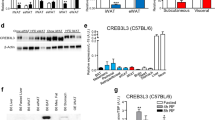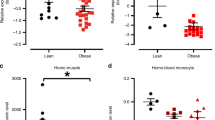Abstract
Metabolic syndrome is a combination of medical disorders that increases the risk of developing cardiovascular disease and diabetes. Constitutive overexpression of 11β-HSD1 in adipose tissue in mice leads to metabolic syndrome. In the process of generating transgenic mice overexpressing 11β-HSD1 in an inducible manner, we found a metabolic syndrome phenotype in control, transgenic mice, expressing the reverse tetracycline-transactivator (rtTA) in adipose tissue. The control mice exhibited all four sequelae of metabolic syndrome (visceral obesity, insulin resistance, dyslipidemia, and hypertension), a pro-inflammatory state and marked hepatic steatosis. Gene expression profiling of the adipose tissue, muscle and liver of these mice revealed changes in expression of genes involved in lipid metabolism, insulin resistance, and inflammation. Transient transfection of rtTA, but not tTS, into 3T3-L1 cells resulted in lipid accumulation. We conclude that expression of rtTA in adipose tissue causes metabolic syndrome in mice.






Similar content being viewed by others
References
Brinster RL, Chen HY, Warren R, Sarthy A, Palmiter RD (1982) Regulation of metallothionein–thymidine kinase fusion plasmids injected into mouse eggs. Nature 296:39–42
Ford ES, Giles WH, Dietz WH (2002) Prevalence of the metabolic syndrome among US adults: findings from the third National Health and Nutrition Examination Survey. JAMA 287:356–359
Frank DU, Elliott SA, Park EJ, Hammond J, Saijoh Y, Moon AM (2007) System for inducible expression of cre-recombinase from the Foxa2 locus in endoderm, notochord, and floor plate. Dev Dyn 236:1085–1092
Govindarajan V, Harrison WR, Xiao N, Liang D, Overbeek PA (2005) Intracorneal positioning of the lens in Pax6-GAL4/VP16 transgenic mice. Mol Vis 11:876–886
Horobin RW, Kiernan J (2002) Conn’s biological stains. Oxford University Press, Oxford
Hughes TR, Mao M, Jones AR, Burchard J, Marton MJ, Shannon KW, Lefkowitz SM, Ziman M, Schelter JM, Meyer MR, Kobayashi S, Davis C, Dai H, He YD, Stephaniants SB, Cavet G, Walker WL, West A, Coffey E, Shoemaker DD, Stoughton R, Blanchard AP, Friend SH, Linsley PS (2001) Expression profiling using microarrays fabricated by an ink-jet oligonucleotide synthesizer. Nat Biotechnol 19:342–347
Hummel KP, Dickie MM, Coleman DL (1966) Diabetes, a new mutation in the mouse. Science 153:1127–1128
Hunt CR, Ro JH, Dobson DE, Min HY, Spiegelman BM (1986) Adipocyte P2 gene: developmental expression and homology of 5′-flanking sequences among fat cell-specific genes. Proc Natl Acad Sci USA 83:3786–3790
Ingalls AM, Dickie MM, Snell GD (1950) Obese, a new mutation in the house mouse. J Hered 41:317–318
Jaubert J, Patel S, Cheng J, Segre JA (2004) Tetracycline-regulated transactivators driven by the involucrin promoter to achieve epidermal conditional gene expression. J Invest Dermatol 123:313–318
Knostman KA, Venkateswaran A, Zimmerman B, Capen CC, Jhiang SM (2007) Creation and characterization of a doxycycline-inducible mouse model of thyroid-targeted RET/PTC1 oncogene and luciferase reporter gene coexpression. Thyroid 17:1181–1188
Kurtz TW, Morris RC, Pershadsingh HA (1989) The Zucker fatty rat as a genetic model of obesity and hypertension. Hypertension 13:896–901
Le YZ, Zheng W, Rao PC, Zheng L, Anderson RE, Esumi N, Zack DJ, Zhu M (2008) Inducible expression of cre recombinase in the retinal pigmented epithelium. Invest Ophthalmol Vis Sci 49:1248–1253
McCloskey DT, Turnbull L, Swigart PM, Zambon AC, Turcato S, Joho S, Grossman W, Conklin BR, Simpson PC, Baker AJ (2005) Cardiac transgenesis with the tetracycline transactivator changes myocardial function and gene expression. Physiol Genomics 22:118–126
Moller DE, Kaufman KD (2005) Metabolic syndrome: a clinical and molecular perspective. Annu Rev Med 56:45–62
Morimoto M, Kopan R (2009) rtTA toxicity limits the usefulness of the SP-C-rtTA transgenic mouse. Dev Biol 325:171–178
Naar AM, Beaurang PA, Zhou S, Abraham S, Solomon W, Tjian R (1999) Composite co-activator ARC mediates chromatin-directed transcriptional activation. Nature 398:828–832
Phan J, Reue K (2005) Lipin, a lipodystrophy and obesity gene. Cell Metab 1:73–83
Rao P, Monks DA (2009) A tetracycline-inducible and skeletal muscle-specific Cre recombinase transgenic mouse. Dev Neurobiol 69:401–406
Rico-Bautista E, Flores-Morales A, Fernandez-Perez L (2006) Suppressor of cytokine signaling (SOCS) 2, a protein with multiple functions. Cytokine Growth Factor Rev 17:431–439
Sisson TH, Hansen JM, Shah M, Hanson KE, Du M, Ling T, Simon RH, Christensen PJ (2006) Expression of the reverse tetracycline-transactivator gene causes emphysema-like changes in mice. Am J Respir Cell Mol Biol 34:552–560
Smith SJ, Cases S, Jensen DR, Chen HC, Sande E, Tow B, Sanan DA, Raber J, Eckel RH, Farese RV Jr (2000) Obesity resistance and multiple mechanisms of triglyceride synthesis in mice lacking Dgat. Nat Genet 25:87–90
Sprengel R, Hasan MT (2007) Tetracycline-controlled genetic switches. Handb Exp Pharmacol 178:49–72
Takaya K, Ogawa Y, Isse N, Okazaki T, Satoh N, Masuzaki H, Mori K, Tamura N, Hosoda K, Nakao K (1996) Molecular cloning of rat leptin receptor isoform complementary DNAs—identification of a missense mutation in Zucker fatty (fa/fa) rats. Biochem Biophys Res Commun 225:75–83
Tartaglia LA, Dembski M, Weng X, Deng N, Culpepper J, Devos R, Richards GJ, Campfield LA, Clark FT, Deeds J, Muir C, Sanker S, Moriarty A, Moore KJ, Smutko JS, Mays GG, Wool EA, Monroe CA, Tepper RI (1995) Identification and expression cloning of a leptin receptor, OB-R. Cell 83:1263–1271
Thomas MK, Devon ON, Lee JH, Peter A, Schlosser DA, Tenser MS, Habener JF (2001) Development of diabetes mellitus in aging transgenic mice following suppression of pancreatic homeoprotein IDX-1. J Clin Invest 108:319–329
Traykova-Brauch M, Schonig K, Greiner O, Miloud T, Jauch A, Bode M, Felsher DW, Glick AB, Kwiatkowski DJ, Bujard H, Horst J, von Knebel DM, Niggli FK, Kriz W, Grone HJ, Koesters R (2008) An efficient and versatile system for acute and chronic modulation of renal tubular function in transgenic mice. Nat Med 14:979–984
Weng L, Dai H, Zhan Y, He Y, Stepaniants SB, Bassett DE (2006) Rosetta error model for gene expression analysis. Bioinformatics 22:1111–1121
Yang VW, Christy RJ, Cook JS, Kelly TJ, Lane MD (1989) Mechanism of regulation of the 422(aP2) gene by cAMP during preadipocyte differentiation. Proc Natl Acad Sci USA 86:3629–3633
Zhang Y, Proenca R, Maffei M, Barone M, Leopold L, Friedman JM (1994) Positional cloning of the mouse obese gene and its human homologue. Nature 372:425–432
Zhu Z, Zheng T, Lee CG, Homer RJ, Elias JA (2002) Tetracycline-controlled transcriptional regulation systems: advances and application in transgenic animal modeling. Semin Cell Dev Biol 13:121–128
Acknowledgments
We thank the Rosetta Gene Expression Laboratories for processing the samples, and the anonymous reviewer for improving the manuscript.
Conflict of interest
All authors in this manuscript worked, at the time the research was carried out, at Merck Research Laboratories.
Author information
Authors and Affiliations
Corresponding author
Electronic supplementary material
Below is the link to the electronic supplementary material.
Rights and permissions
About this article
Cite this article
Zhang, L., Zhou, Y., Zhu, A.Y. et al. Metabolic syndrome in mice induced by expressing a transcriptional activator in adipose tissue. Transgenic Res 21, 633–644 (2012). https://doi.org/10.1007/s11248-011-9562-2
Received:
Accepted:
Published:
Issue Date:
DOI: https://doi.org/10.1007/s11248-011-9562-2




